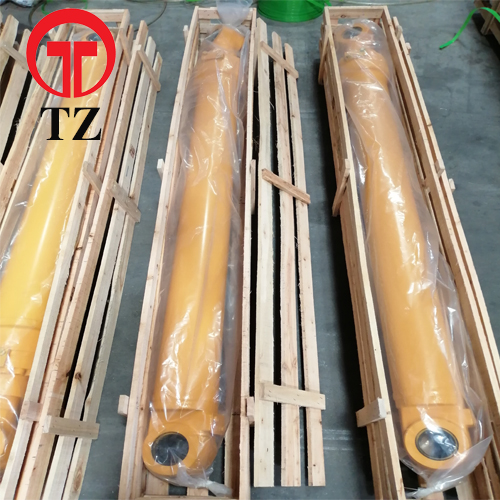Cụm xi lanh gầu thủy lực là bộ phận quan trọng trong máy móc hạng nặng, cung cấp sức mạnh, hiệu quả, và độ bền cần thiết cho nhiệm vụ xử lý vật liệu. Khả năng tạo ra lực cao, cung cấp kiểm soát chính xác, and adapt to various applications makes it an indispensable part of construction, Khai thác, and agricultural equipment.
Understanding the Hydraulic Bucket Cylinder Assembly

A. Hydraulic System Overview:
Power Transmission: Hydraulic systems utilize fluid pressure to generate force and transmit power. They are often employed in heavy machinery due to their ability to handle high loads and provide smooth and controlled movement.
Key Components: The hydraulic bucket cylinder assembly consists of various components, including the cylinder, pít-tông, gậy, con dấu, và dòng thủy lực. Together, these components enable the conversion of hydraulic energy into mechanical force to facilitate the movement of the bucket or attachment.
B. Functionality and Operation:
Hydraulic Pressure Generation: The hydraulic system from hydraulic BUCKET cylinder assembly Manufacturer, generates pressure by pumping hydraulic fluid, typically oil, into the cylinder. This pressurized fluid acts on the piston, creating the force necessary to extend or retract the cylinder.
Linear Motion: As hydraulic fluid enters the cylinder, it pushes the piston and rod, resulting in linear motion. This motion can be utilized to control the position and movement of the bucket or attachment, allowing for excavation, loading, or other material handling tasks.
Key Features and Advantages of Hydraulic Bucket Cylinder Assembly
A. Power and Force:
High Force Generation: Hydraulic systems provide substantial force output, enabling heavy machinery to handle demanding tasks with ease. The hydraulic bucket cylinder assembly ensures the necessary force is applied to move heavy loads, enhancing operational efficiency.
Precise Control: Hydraulic systems offer precise control over movement, allowing operators to manipulate the bucket or attachment with accuracy. This precision is crucial for delicate operations, such as fine grading or material placement.
B. Efficiency and Productivity:
Rapid Operation: Hydraulic systems enable quick response times, facilitating efficient cycle times for repetitive tasks. The hydraulic bucket cylinder assembly ensures swift and smooth bucket movements, reducing overall operation time and increasing productivity.
Versatility: Hydraulic systems can be adapted to various heavy machinery applications, making them highly versatile. The hydraulic bucket cylinder assembly can be customized to fit specific equipment requirements, allowing for seamless integration with different types of machinery.
C. Durability and Reliability:
Robust Construction: Hydraulic cylinders are built to withstand heavy loads, harsh environments, and rigorous operating conditions. They are designed with durable materials such as high-strength steel, ensuring longevity and reliability.
Resistance to Contaminants: Hydraulic systems incorporate seals and gaskets that prevent contamination from entering the cylinder. This feature protects the internal components from dirt, debris, and moisture, minimizing the risk of damage and ensuring consistent performance.
Maintenance and Considerations
A. Regular Inspection and Maintenance:
Fluid Checks: Regularly inspect hydraulic fluid levels and quality, ensuring proper lubrication and contamination prevention. Replace the fluid as recommended by the manufacturer.
Seal and Gasket Inspection: Inspect seals and gaskets for wear or damage. Replace them promptly to maintain the integrity of the hydraulic system.
B. Operating Considerations:
Load Capacity: Ensure the hydraulic bucket cylinder assembly is rated for the intended load capacity. Overloading the system can lead to premature failure and unsafe operation.
Proper Usage: Follow manufacturer guidelines for operating the machinery and the hydraulic system to prevent unnecessary stress on the hydraulic bucket cylinder assembly.
